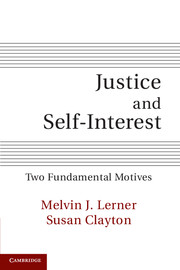Book contents
- Frontmatter
- Contents
- List of Figures and Tables
- Preface
- 1 Contesting the Primacy of Self-Interest
- 2 Why Does Justice Matter? The Development of a Personal Contract
- 3 Commitment to Justice: The Initial Primary Automatic Reaction
- 4 Explaining the Myth of Self-Interest
- 5 Defining the Justice Motive: Reintegrating Procedural and Distributive Justice
- 6 How People Assess Deservingness and Justice: The Role of Social Norms
- 7 Integrating Justice and Self-Interest: A Tentative Model
- 8 Maintaining the Commitment to Justice in a Complex World
- 9 Bringing It Closer to Home: Justice in Another “American Tragedy”
- 10 Emotional Aftereffects: Some Negative Consequences and Thoughts on How to Avoid Them
- References
- Author Index
- Subject Index
5 - Defining the Justice Motive: Reintegrating Procedural and Distributive Justice
Published online by Cambridge University Press: 03 May 2011
- Frontmatter
- Contents
- List of Figures and Tables
- Preface
- 1 Contesting the Primacy of Self-Interest
- 2 Why Does Justice Matter? The Development of a Personal Contract
- 3 Commitment to Justice: The Initial Primary Automatic Reaction
- 4 Explaining the Myth of Self-Interest
- 5 Defining the Justice Motive: Reintegrating Procedural and Distributive Justice
- 6 How People Assess Deservingness and Justice: The Role of Social Norms
- 7 Integrating Justice and Self-Interest: A Tentative Model
- 8 Maintaining the Commitment to Justice in a Complex World
- 9 Bringing It Closer to Home: Justice in Another “American Tragedy”
- 10 Emotional Aftereffects: Some Negative Consequences and Thoughts on How to Avoid Them
- References
- Author Index
- Subject Index
Summary
Having established the importance of justice, in this chapter we further explore its definition. In particular, we will review the relatively recent history of “procedural justice” as a form of justice that is distinct from the earlier focus on “distributive justice.” After carefully examining some of the prototypical and most highly cited research that illustrates the unique status of procedural justice, we will make the case that the distinction between procedural and distributive justice does not “carve nature at its joints”; that is, divide two things where they ought to be divided: it is a confused and confusing distinction. The only reliable difference between these two types of justice is in the desired resources involved. Procedural justice refers to the acquisition and distribution of “symbolic” resources, while distributive justice research and theory typically includes both symbolic and concrete resources. The available evidence confirms that, when we attempt to explain and predict how the concern with justice and deservingness appear in people's lives, the same social psychological processes apply to the acquisition and distribution of both essentially fungible and interchangeable kinds of resources, symbolic or concrete. In essence, justice consists of people getting what they deserve, or what they are entitled to have on the basis of who they are and/or what they have done. We close with a discussion of the relationship between justice and other moral mandates.
- Type
- Chapter
- Information
- Justice and Self-InterestTwo Fundamental Motives, pp. 98 - 121Publisher: Cambridge University PressPrint publication year: 2011

